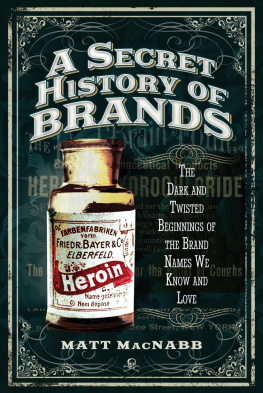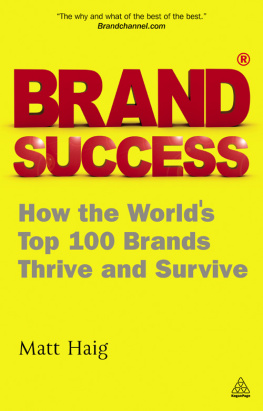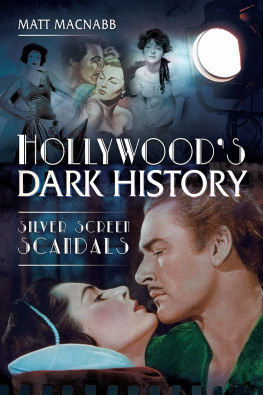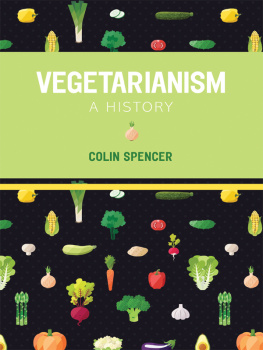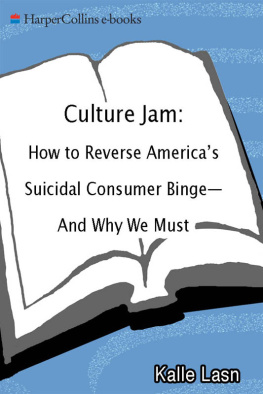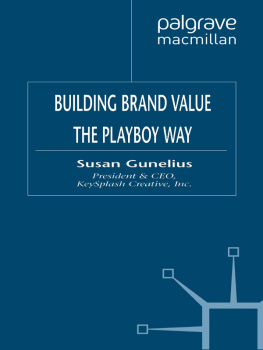
A Secret History of Brands
A Secret History of Brands
The Dark and Twisted Beginnings of the Brand Names We Know and Love
Matt MacNabb
First published in Great Britain in 2017 by
Pen & Sword History
an imprint of
Pen & Sword Books Ltd
47 Church Street
Barnsley
South Yorkshire
S70 2AS
Copyright Matt MacNabb, 2017
ISBN 978 1 47389 417 4
eISBN 978 1 47389 419 8
Mobi ISBN 978 1 47389 418 1
The right of Matt MacNabb to be identified as Author of this work has been asserted by him in accordance with the Copyright,
Designs and Patents Act 1988.
A CIP catalogue record for this book is available from the British Library.
All rights reserved. No part of this book may be reproduced or transmitted in any form or by any means, electronic or mechanical including photocopying, recording or by any information storage and retrieval system, without permission from the Publisher in writing.
Pen & Sword Books Ltd incorporates the Imprints of Pen & Sword Books
Archaeology, Atlas, Aviation, Battleground, Discovery, Family History, History,
Maritime, Military, Naval, Politics, Railways, Select, Transport, True Crime,
Fiction, Frontline Books, Leo Cooper, Praetorian Press, Seaforth Publishing,
Wharncliffe and White Owl.
For a complete list of Pen & Sword titles please contact
PEN & SWORD BOOKS LIMITED
47 Church Street, Barnsley, South Yorkshire, S70 2AS, England
E-mail:
Website: www.pen-and-sword.co.uk
List of Illustrations
John Sith Pemberton portrait (Author unknown, Source: Creative Commons).
Vintage Coca-Cola advertisement.
Vintage Coca-Cola advertisement (c. 1911).
Hugo Boss company newspaper advertisement (date unknown).
Pembertons French Wine Coca newspaper advertisement.
Henry Ford Portrait (c. 1919, Hartsook, photographer. Source: Library of Congress).
Henry Ford with the ten millionth Model T (Source: Library of Congress).
The Dearborn Independent newspaper (1920).
Jesse Owens at start of record breaking 200 meter race (1936, Source: Library of Congress).
Hugo F. Bosss Nazi membership (c. 1931).
The Dassler shoe factory (Source: Library of Congress).
Coco Chanel portrait (c. 1910, Source: Library of Congress).
Der Fhrer in Paris Adolf Hitler visiting occupied Paris, France (c. 1940, Source: The National Archives).
Ford Factory assembly line (c. 1913, Source: Library of Congress).
Bayer heroin newspaper advertisement (c. 1901).
Bayer & Co. bottle of heroin.
Entrance to the German death camp Auschwitz, in Poland (Logaritmo, Photographer, Source: Creative Commons).
John Harvey Kellogg portrait (c. 1914, Source: Library of Congress).
Vintage Kelloggs cereal advertisement (c. 1915, Source: Library of Congress).
Vintage Kelloggs cereal advertisement (c. 1919, Source: Library of Congress).
Workers outside of the Winchester Repeating Arms Company (c. 1897, Source: Library of Congress).
The Winchester mansion (c. 1980, HABS, photographer, Source: Library of Congress).
Sarah Winchesters bedroom (c. 1980, HABS, photographer, Source: Library of Congress).
The Winchester mansion living room fireplace (c. 1980, HABS, photographer, Source: Library of Congress).
Leo Baekeland portrait (c. 1906, Source: Library of Congress).
Bakelite laboratory in Younkers, NY (c. 1935, Source: Bakelite Review/ Library of Congress).
Vintage Bakelite magazine advertisement (Source: Library of Congress).
Bakelite jewellery colours (c. 1924, Source: Gifts to Treasure, Embed Art Company catalogue).
Acknowledgements
I would first and foremost like to thank my lovely wife Holly for her patience and support, along with our four children Sebastian, Anastasia, Alexandre and Callidora. Youre the light of my life.
Thank you to Claire Hopkins and everyone at Pen and Sword Books for believing in me and this project. Also a special thanks to Karyn Burnham for her fantastic editorial assistance.
Special thanks also to author MaryJo Ignoffo and finally Phillipp Mimkes of the CBG Network.
Introduction
A brand is often developed around a name, logo, distinct packaging and/or a dedicated mascot. Brand name products are such a part of our daily life and identity that it is difficult to imagine a world where they dont exist. There was a time, not all that long ago, when we werent defined by the type of car we drove or the brand of clothing or shoes on our bodies. Today, our culture thrives on brands in every facet of our life. These brands have all emerged into the post-Industrial Revolution marketplace and have become an enduring part of our daily lives over the past century. You might think of Bayer when you have a headache, Coca-Cola when you want a drink and perhaps Ford when youre car shopping. These brands are taken for granted today, but they all started somewhere and for many of the brands you know and love, their roots are firmly planted in dark, twisted, and sometimes violent, origins. These arent the stories that youll read on the carefully crafted and orchestrated modern corporate histories of companies like Chanel or Adidas. These are the true stories of the brands you know and the often very flawed individuals who created them.
The landscape of both life and industry were very different prior to the events of the Industrial Revolution. The inception of brand names and corporations is relatively new; before the development of mass manufacturing and industrialisation one had to rely on self-production or regionally produced products. Society, in both America and Europe, was comprised primarily of rural and agrarian culture. There were some cities, like London, that had grown and expanded as a capital city, but most of the towns and villages were self-sustaining. If you lived in a village you would have your own on-site bakers, butchers and blacksmiths, and you would often have to hunt for, or grow, most of your own food. If you lived in a rural setting and wanted clothing, food or other goods, there were no stores to visit. If you were lucky you had in-demand goods to barter and trade for other goods or services, but this process was spotty and largely unorganised. The more common occurrence was malnourishment and even starvation when things got difficult. There were no food banks or charities. If there was a bad crop or other pressingly negative issues in your region, any neighbours you had were likely suffering to a similar degree.
This way of living carried over to the Americas in the seventeenth century, when the thirteen colonies that would eventually become the United States were settled. The colonies would self-govern, even though there was still the British monarchy to answer to back at home across the ocean. The local landowners would vote for a provincial government and governor to oversee the goings-on there. When you came to the new world it was, literally, starting over. There were no buildings and no cities or roads. There was only wilderness and the Native Americans who already resided there.
This way of life would soon change, as the Industrial Revolution began to take shape in England. There were certain factors that were necessary for one central area to be the focal point of the coming industrialisation; the demands of the eighteenth and nineteenth century included vital, and bountiful, naturally occurring deposits of commodities like coal and iron ore. Other materials were needed, but if a country had a vast colonisation system in place around the world, then various raw materials could be easily mined and imported. The best option in the world at the time and that was Britain. It was the natural birthplace of big industry. In eighteenth-century Britain, the textile and iron industries were transformed in a major way.
Next page
